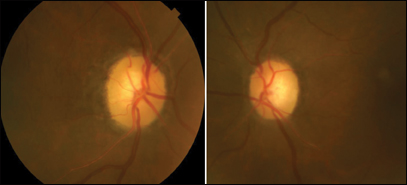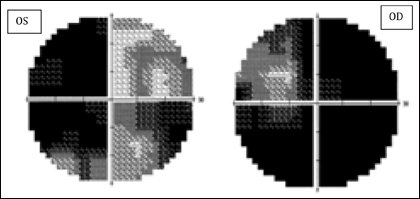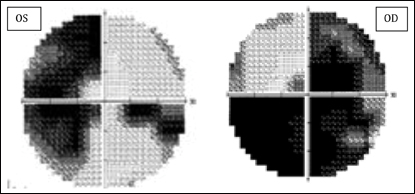Man presents with slow, progressive vision loss
The cup-to-disc ratio was 0.65 bilaterally, and there was moderate temporal pallor of both optic nerves.
A 61-year-old man visiting from the Ivory Coast presented to the New England Eye Center for slow, progressive vision loss in both eyes starting 2 to 3 years before presentation. His medical history was significant only for hypertension and gout. His family ocular history included his father, who was blind in one eye possibly due to a retinal detachment. He was evaluated by his local ophthalmologist on several occasions, but an etiology was never determined. Before his evaluation at the New England Eye Center, our patient was seen at another eye clinic in the United States and was told he may have a maculopathy.
Examination
On exam, best corrected visual acuities were count fingers at 8 feet eccentrically in the right eye and 20/200 in the left eye. Pupils were round, equal and reactive without relative afferent pupillary defect. The patient was unable to identify the Ishihara control plate in either eye. Extraocular movements were full bilaterally. Anterior segment exam was remarkable only for 1+ nuclear sclerosis bilaterally. Dilated fundus exam was remarkable for a white linear scar extending from the inferior arcade to the temporal aspect of the macula in the right eye (Figure 1). The cup-to-disc ratio was 0.65 bilaterally, and there was moderate temporal pallor of both optic nerves (Figure 2).

Images: Moon J, Vuong L

What is your diagnosis?
Progressive vision loss
The differential for bilateral disc atrophy with progressive vision loss is fairly wide but can be categorized into compressive, mitochondrial, vascular, infectious vs. noninfectious optic neuritis, and infiltrative.
Given the presentation of bilateral progressive vision loss, a compressive lesion is high on the list. Pituitary lesions, such as an adenoma or a craniopharyngioma, meningioma or slow-growing aneurysm are most common. Dominant optic atrophy could also be considered in the setting of bilateral progressive vision loss with large cup-to-disc ratios and temporally pale optic discs; however, there was no family history of unexplained bilateral vision loss.
Noninfectious causes of optic neuropathies, including sarcoidosis and demyelinating (including neuromyelitis optica), as well as infectious causes of optic neuritis, including TB and syphilis, were considered, but the time course did correspond with this category of diseases. Bilateral anterior ischemic optic neuropathy was also considered, but our patient lacked the acute onset of vision loss commonly consistent with this disease. As for non-arteritic anterior ischemic optic neuropathy, there is rarely progression. Arteritic anterior ischemic optic neuropathy could progress without the appropriate treatment; however, the progression is typically rapid, and patients often have other systemic symptoms. Infiltrative causes such as lymphoma and leukemia were also on the differential but less likely given a negative review of systems.
Diagnosis and management
OCT of the macula showed normal retinal anatomy in both eyes. OCT showed the retinal nerve fiber layer and ganglion cell layer complex were bilaterally thin (Figure 3). Humphrey visual field testing using the 30-2 SITA Fast protocol showed diffuse depression suggestive of a bitemporal hemianopia (Figure 4).
MRI of the orbits with and without contrast and FLAIR sagittal reformatting of the brain showed a large suprasellar mass measuring approximately 3.5 cm × 4.9 cm × 4.8 cm that was protruding into the sphenoid sinus and compressing the optic chiasm (Figure 6). The optic nerves appeared atrophic bilaterally.
The patient was referred to neurosurgery and endocrinology for further evaluation and management. Blood work revealed panhypopituitarism. He underwent resection of the mass via an endoscopic transsphenoidal approach. Pathology confirmed a pituitary macroadenoma.




Discussion
Pituitary adenomas are the most common cause of compression of the chiasm. They are seen more commonly in adults with rare occurrences in children. Pituitary adenomas are typically classified into a microadenoma if less than 10 mm or a macroadenoma if greater than 10 mm. Vision loss may be the first and only symptom of a pituitary adenoma, especially if it is a non-secreting tumor. Thus, ophthalmologists play an important role in the diagnosis.
Once a pituitary adenoma is diagnosed, the patient must be referred to endocrine for hormone surveillance and neurosurgery for possible surgical resection. Typically the presence of vision loss with documented visual field defects indicates the need for surgical resection. If there is no visual field defect, medical therapy for prolactin secreting tumors or observation are alternatives.
The visual prognosis after surgery is good. Studies have shown rates of improvement in postoperative visual acuity ranging anywhere from 74% to 90%. Younger age, shorter duration of symptoms before adenoma removal and preoperative vision of 20/100 or better are associated with better visual outcomes. Less clear prognostic indicators include severity of the visual field defect and optic disc pallor.
After surgery, the ophthalmologist should continue close follow-up because vision loss is often the first sign of recurrence. A baseline visual field and acuity should be performed several months after the surgery. Afterward, an interval of 6 to 12 months, depending on the case, is appropriate. The patient must also receive periodic imaging.
Conclusion
The patient did well after the surgery with an uncomplicated postoperative course. He noticed an improvement in his vision almost immediately after the surgery. During his ophthalmology examination 2 months postoperatively, vision in the right eye was stable at count fingers at 8 feet and improved to 20/30 in the left eye. Humphrey visual fields also showed an improvement in both eyes, but more significantly in the left (Figure 5). He is also being followed by endocrine and receiving hormone replacement therapy including levothyroxine, steroids and testosterone. The etiology of the scar in his right macula is unclear but could have possibly been caused by a larva. However, it is clear that the scar was unrelated to his vision loss and may have been a red herring in his “occult maculopathy” diagnosis.
- References:
- Barzaghi LR, et al. Neurosurg Rev. 2012;doi:10.1007/s10143-011-0365-y.
- Chhabra VS, et al. Compr Ophthalmol Update. 2006;7(5):225-240.
- Gittinger JW. Tumors of the pituitary gland. In: Miller NR, Newman NJ, eds. Walsh and Hoyt’s Clinical Neuro-Ophthalmology. Vol 2. 6th ed. Philadelphia: Lippincott Williams & Wilkins; 2005:1531-1546.
- Jacob M, et al. Value of optical coherence tomography (OCT) in predicting visual outcome after treatment of pituitary adenoma. Presented at: North American Neuro-Ophthalmology Society meeting; March 2008; Orlando, Fla.
- Kerrison JB, et al. Am J Ophthalmol. 2000;doi:10.1016/S0002-9394(00)00539-0.
- Monteiro ML, et al. Can J Ophthalmol. 2010;doi:10.3129/i09-276.
- Neuro-Ophthalmology. Basic and clinical science course, Section 5. American Academy of Ophthalmology; 2010:159-165.
- For more information:
- Jessica Moon, MD, and Laurel Vuong, MD, can be reached at New England Eye Center, Tufts University School of Medicine, 750 Washington St., Box 450, Boston, MA 02111; website: www.neec.com.
- Edited by Kristen E. Dunbar, MD, and Kendra Klein, MD. They can be reached at New England Eye Center, Tufts University School of Medicine, 750 Washington St, Box 450, Boston, MA 02111; website: www. neec.com.
